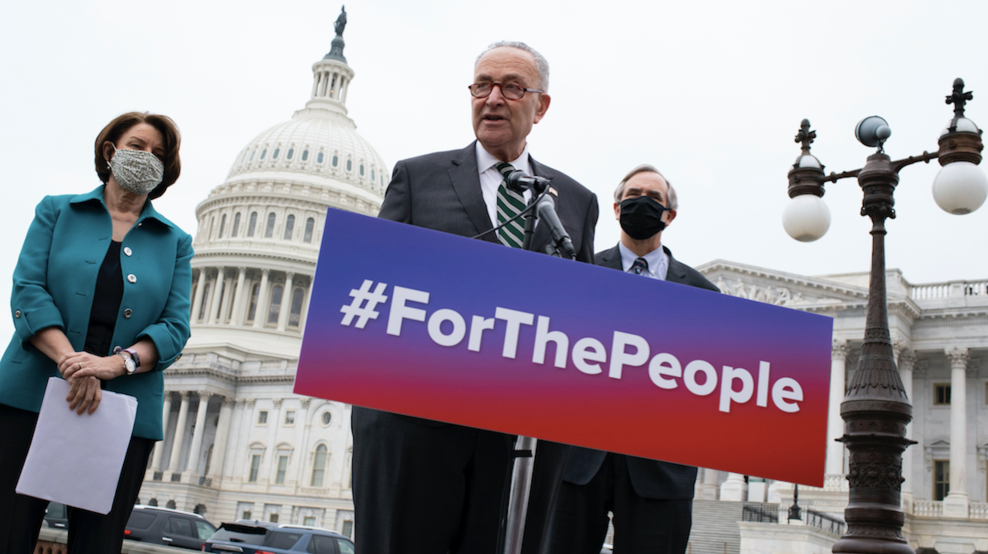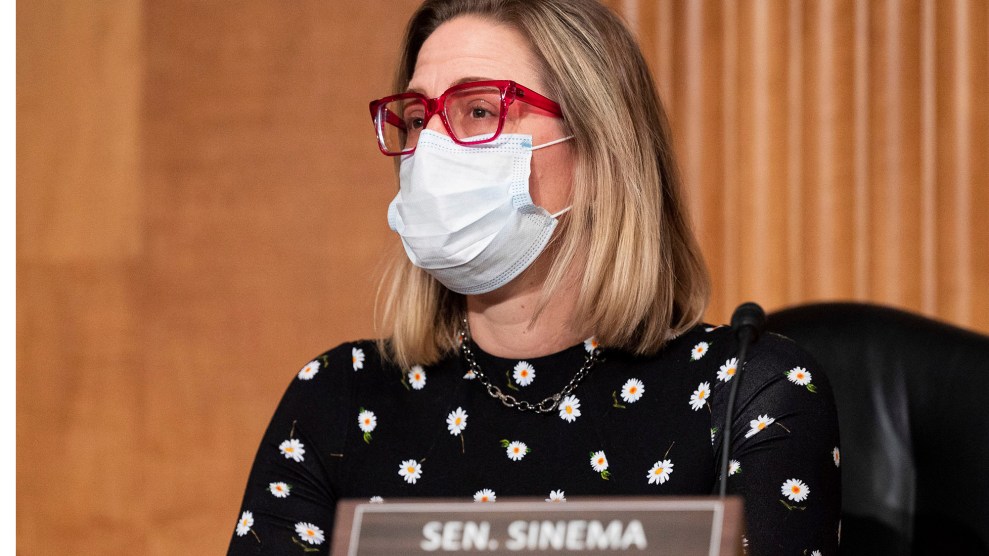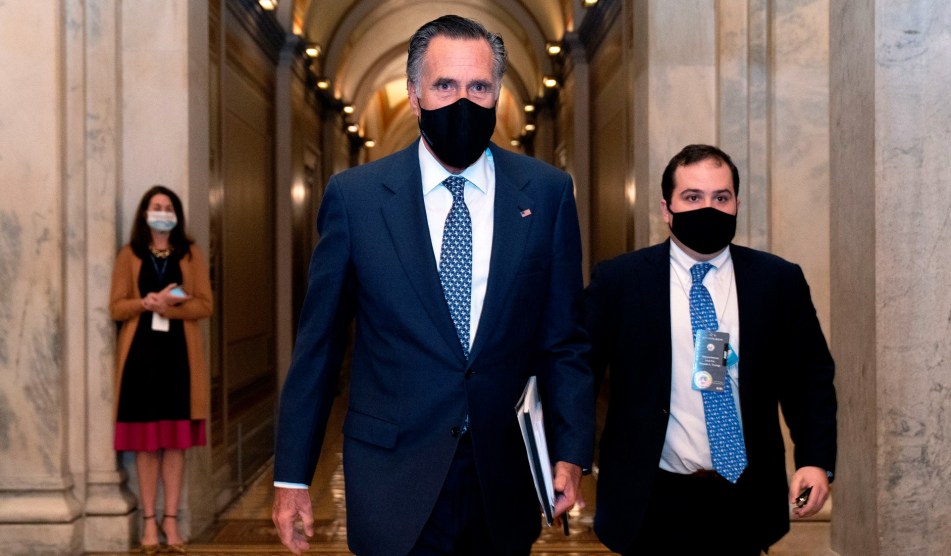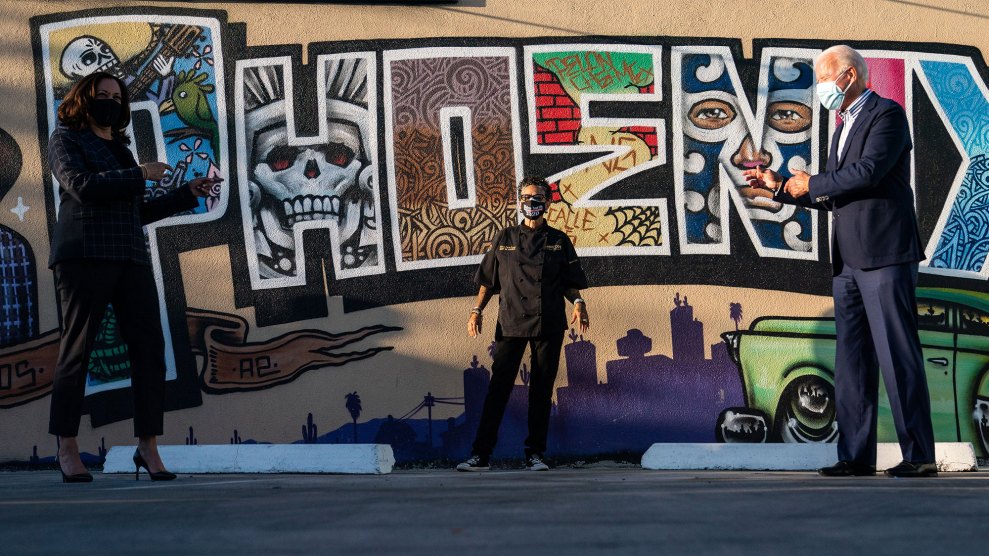Kyrsten Sinema wasn’t the only Democrat to vote against including a $15 federal minimum wage in the $1.9 trillion Covid relief bill in early March, but she was the only one whose vote became a meme. The clip itself is short and sparse: Sinema, the 44-year-old first-term Democratic senator from Arizona, walks briskly around the well of the chamber, gives Mitch McConnell a friendly pat on the back, and pauses in front of the clerk. Then she thrusts her right thumb dramatically down, dipping her body for emphasis.
“Ms. Sinema. Ms. Sinema: No,” says the clerk, recording her vote. But Sinema, by this point, is already gone.
For more articles read aloud: download the Audm iPhone app.
That morning, she had brought a chocolate cake for the floor staff who worked long hours before the final stimulus vote. Now “Marie Antoinette” was trending on Twitter. Within a few hours, the image was everywhere—on cable news, late-night shows, even the side of an old flour mill in downtown Tempe, near the intersection where, in 2003, Sinema led an anti-war vigil on the eve of the invasion of Iraq. “Keep the cake,” read the message projected onto the building. “Support the $15 minimum wage now.”
To Sinema’s progressive critics, her vote was a funhouse mirror image of John McCain’s thumbs-down vote to save the Affordable Care Act four years earlier—only now an Arizona Democrat was rejecting one of her party’s biggest legislative priorities. More alarming was her opposition to reforming the filibuster, the Senate rule that allows a minority of senators to block a piece of legislation from coming to a vote. Weeks earlier, Sinema, who rarely speaks to reporters from news outlets that are not based in her home state, had drawn a sharp line during an interview with Politico: “I want to restore the 60-vote threshold for all elements of the Senate’s work,” she said. In the face of united Republican opposition, many Democrats feared such a standard would doom almost every piece of their agenda—from immigration reform to voting rights to LGBTQ equality.
Democrats expected such intransigence from West Virginia’s Joe Manchin, a conservative from a state Donald Trump carried by 39 points, who once shot climate legislation with a gun and whose wife cuts his hair with a Flowbee. But to those who have supported Sinema from the beginning of her career, her heel-turn is more painful. Long before she became one of the Democratic caucus’s most centrist members, Sinema was so liberal she refused to even join the party. From her family’s struggle with poverty during her childhood to her Green Party roots, her rise is the story of striving and adaptation, and of the transformation not just of an idealist, but of a state—from a Republican stronghold she once dubbed the “meth lab of democracy” to a bona fide battleground.
But in the process, Sinema has left some back home wondering whether she’s misread the lessons of her own ascent. As a progressive in one of the nation’s most conservative state legislatures, Sinema abandoned her early radicalism for a new theory of change. She learned to play nice, seeking incremental progress through careful messaging and across-the-aisle relationships, and reinventing herself as a post-partisan deal-maker. But her success was also powered by an army of activists—outsiders like she had once been—operating on a far different theory of change. Now, for the first time in her career, she holds real power. The future of the party and the Senate just might hinge on what Kyrsten Sinema wants to do with it.

When Sinema tried to explain why she opposed the minimum-wage hike, she began, as she often does, with a nod to her past. “I understand what it is like to face tough choices while working to meet your family’s most basic needs,” she said in a statement. While critics called her a hypocrite and pointed to comments in which she had previously endorsed a higher wage, Sinema insisted she still did support an increase. Her issue, she said, was that the wage increase had nothing to do with Covid relief. Sinema had become a stickler for the rules. She didn’t start off that way.
The hardships Sinema faced growing up have long formed the foundational story of her politics. Born in Tucson, she moved with her family when she was 8 to a rural community in the Florida panhandle after her parents divorced. While her new stepfather struggled to find work, they settled across the street from relatives, in a cinder-block building that had once been a gas station; she said they subsisted with help from members of the LDS church to which they belonged. The details of the living arrangement are a matter of dispute—she has often said their home lacked electricity and running water, although relatives insisted to the Washington Post in 2018 that it had both. But a gas station with running water is a gas station nonetheless. Sinema grew up poor and from a young age was possessed with a relentless drive to change her own circumstances.
At 16, she was co-valedictorian of her high school class. Two years later, she graduated from Brigham Young University. She moved to Phoenix, got married at 19 and divorced within a few years, and became a social worker at an elementary school in a Mexican American neighborhood. Sinema worked for Ralph Nader’s 2000 presidential bid, managed a campaign for a Green Party state legislative candidate named John Scudder, got a master’s in social work at Arizona State University, and in 2001 launched her first campaign—for a seat on the city council. Her interests, she told a local newspaper, were housing and poverty; she raised practically nothing because she believed donations were “bribery.”
“What Kyrsten had to say was always a million times smarter than what anyone else had to say,” says Carole Edelsky, a retired Arizona State University professor who volunteered on the Scudder campaign. “She was head and shoulders above everybody. She was gorgeous and brilliant. She was a lightning rod. She just sparkled.” Sinema was active in every political club and attended every meeting. “She just struck me as somebody who slept like two or three hours at night,” another activist says.
During that first campaign, Sinema auditioned for a part in a community theater production of Jacob’s Gift, an original play “about a young Jewish couple who just had their baby boy, and it was a big decision as to whether or not to have a bris,” explains Janet Arnold Rees, a local theater mainstay who played Sinema’s character’s mother in the show.
Even back then Sinema could sometimes be hard to pin down. Rees, who praised her co-star as “a delight—and a very talented actor,” recalls Sinema describing herself as a “libertarian.” A spokesperson claimed during one of her congressional campaigns that she had joined the Green Party because she was interested in sustainability. The play’s program identified her simply as a city council candidate who “loves shoes and purses and hates macrame owls.”
When an anti-circumcision activist wrote to congratulate her on the show, she wrote back at length, unpacking her own thoughts on the play and on the nature of belief more broadly. Sinema, who had left the LDS church after college and currently claims no religious affiliation, explained that she was drawn to her character, Eileen, because of the way she challenged the strictures imposed on her by tradition.
“I am interested in religious thought, customs and rituals, and have always been fascinated with the idea that people in societies do things just because ‘they’re supposed to,’” Sinema wrote. “Organized religion, by its very definition, prescribes a set of rules and then tells its ‘followers’ to live by these rules. I liked Eileen because she questioned and thought for herself.”
But Sinema felt betrayed by the ending, in which her character at last bows to tradition. “Eileen should have done more with her conviction,” Sinema wrote. “A person with conviction who gives in still gives in, and that is what is remembered in the end. I hope that one day she doesn’t give in.”
By the time the votes were tallied in her city council race on September 11, 2001, Sinema’s doomed city council campaign was an afterthought. A few days later, Congress authorized a global war on terror, and a small but determined group of activists in Phoenix, calling themselves the Arizona Alliance for Peaceful Justice (AAPJ), began discussing how to push back. Sinema dropped by an early organizing session at a Quaker meeting house in Tempe and threw herself into the anti-war cause.
In a movement that sometimes drifted toward chaos, Sinema emerged as a natural leader—“in charge without being ‘I’m the boss’ kind of in charge,” says Seth Pollack, a former Green Party activist. She organized protests and invited members over to her house near downtown Phoenix to make signs beforehand. (For the uninspired, Sinema even suggested slogans—“Bombing for Peace Is Like Fucking for Virginity”; “Real Patriots Drive Hybrids.”) On “occasions where she wanted to draw attention,” an AAPJ member recalls, Sinema grabbed a bullhorn and wore a bright pink tutu (an image that would later feature in Republican TV ads). And on Wednesdays after work, Sinema and a small group of women donned black veils and stood in silence outside a public library. She intended to keep the vigils going, Sinema told the Arizona Republic at the time, “’til there’s no more war.”
Only one member of Congress had voted against the war in Afghanistan, and the drumbeat for invading Iraq felt unstoppable. But AAPJ members had their own theory of change, rooted in passion and persistence. For a long time, on its website, AAPJ featured a slightly altered quote from the anthropologist Margaret Mead—a catechism for the righteous but outnumbered: “Never doubt that a small group of thoughtful, committed citizens can change the world; indeed, it’s the only thing that ever does.”
They had a special disdain for would-be allies who coveted power over ideals. When hawkish and conservative-leaning Connecticut Sen. Joe Lieberman passed through Tucson during his presidential campaign in 2003, Sinema led a caravan of activists to protest outside his event. “He’s a shame to Democrats,” she told a reporter. “I don’t even know why he’s running. He seems to want to get Republicans voting for him—what kind of strategy is that?”
Politically speaking, Sinema was still on the fringe. When she ran for state legislature in 2002—this time as an independent—she blamed her defeat on the local Democratic Party, which she said had told voters she was “too extreme for central Phoenix.” But she was honing the skills of a politician too, lobbying for social services at the state Capitol and skillfully navigating the crosscurrents of the anti-war movement.
Peace activist groups, as one member puts it, “are not exactly the model of organizational efficiency,” and AAPJ was no exception. One early meeting devolved into an argument over the name. (“Some people thought it should be AAJP—because the justice had to come first, before the peace,” recalls Korky Day, an early member.) The anti-war movement brought together Quakers and veterans, Wobblies and gun-toting libertarians, united by the one thing they all opposed. The most persistent source of tension was the anarchists, whose militant methods grated on many members. When the anarchists and peaceniks deadlocked over the tactics they used at anti-war demonstrations, Sinema—whose day job as a social worker, after all, involved conflict mediation—brought the two factions together in Tempe to broker a truce.
“She’s always had the inclinations of a social worker—‘sit down and talk and we can reach an agreement on something,’” says Victor Aronow, a longtime peace activist who is still active with the group. “That’s always been one of her strong and weak points simultaneously.”
When the conflict flared up again, the group turned to Starhawk, a self-described witch and ecofeminist from San Francisco who had made a niche for herself in lefty circles by fusing “earth-based spirituality” with political activism. Members of her movement, known as the Pagan Cluster, were involved in the World Trade Organization protests in Seattle, the fight against deforestation, and the anti-war movement.
“They were having conflict between the anarchists and the peace people, and they asked me to come and do a training and a mediation,” Starhawk remembers. “I was really pleased that there were enough anarchists and peace people in Phoenix that they were actually having conflict with each other!”
Starhawk spoke at a teach-in that Sinema helped organize at Arizona State University in 2003, and later that year they linked up again in Miami, where a small delegation of Phoenix activists had decided to participate in a big demonstration against the Free Trade Area of the Americas—a proposed agreement that would turn much of the Western Hemisphere into a NAFTA-like open market.
In Miami, there was a mobile composting toilet that someone was ferrying around on a bicycle, and a “convergence space” in an old warehouse with a permaculture garden inside. Elizabeth Venable, who had traveled with the Phoenix group, remembers Sinema wandering around the day before the march at the Really Really Free Market—where there was no such thing as capitalism, and the clothes and food and plants were all gratis. People paid for items with “fairy money” and traded skills and hugs for goods. It was a glimpse of the world many activists wanted for themselves. And then the next day, they confronted the world as it was.
There had been an ominous undercurrent all week. Police had arrested activists off the street and raided camps in the days before the march. When the tear gas started that afternoon, Sinema was doing a spiral dance near the front of the march—a ritual in which demonstrators formed a long chain, circling back on itself; they hoped to summon energy from their togetherness. (“She Dabbled in Witchcraft” was the headline of a 2018 press release from the National Republican Senatorial Committee. “I think she was just friends with the pagans,” Venable says.) Law enforcement later said it had acted in response to vandalism, but Sinema recounted in an email thread with AAPJ members later that night how the police crackdown had really started.
“The police were the aggressors from the beginning, shoving protesters with batons, then beating protesters, then taser gunning people in the crowd and launching rubber bullets, pepper spray, and tear gas into the crowds, hitting all sorts of people,” she wrote. One of Venable’s friends lost part of his ear. A rubber bullet hit Sinema’s backpack. There was a sense of powerlessness about the way a movement they’d built could be so readily repressed. When she turned on the news that night, she fumed at how the media amplified the police narrative.
“It was brutal,” she wrote.

Miami coincided with the end of Sinema’s career as an outsider. Back in Phoenix, the peace movement had already begun to splinter. Although she could always be counted on for big events, “she sort of faded from the AAPJ scene,” says Aronow. Sinema, for her part, felt that the movement had begun to “stagnate”—they met every two weeks to discuss the same things over and over. She was tired of being irrelevant. She left social work and went to law school, hoping it would unlock her access to “the power attorneys wield,” but “for good.” When she ran for state legislature again in 2004, she did so as a Democrat—and won.
“My political stance has never changed,” she told the Arizona Republic during that race. Operating outside the two-party system just wasn’t getting her anywhere. And for her first few months on the job, operating inside didn’t either. Sinema was, as then–Democratic Gov. Janet Napolitano later put it, “a gadfly”—an “unconventional” and “starry-eyed idealist” who was “suspicious of those who disagreed with her.” In Sinema’s political memoir, Unite and Conquer: How to Build Coalitions That Win and Last, she describes herself during this time as “bright-eyed,” “bushy-tailed,” and “rather annoying.” She gave blistering floor speeches but accomplished nothing.
And then she found a lifeline—a new group, called Arizona Together, that had formed in response to Prop 107, a ballot initiative that sought to ban same-sex marriage in the state. Sinema had not made a secret of her sexual orientation when running for office, but it still came as a surprise to some in the Capitol. After using the word “we” in a floor speech about LGBTQ rights that February—as in, “We’re simply people like everyone else who want and deserve respect”—a reporter asked her what exactly she meant.
“Duh, I’m bisexual,” Sinema said.
The marriage ban seemed unstoppable. Republicans had used same-sex marriage as a battering ram in state after state, winning dozens of referendums while losing none. Among activists, “there was a philosophy called ‘lose forward,’” recalls Joe Yuhas, a consultant for Arizona Together. “The thinking was, ‘It’s a foregone conclusion that we’re gonna lose, so let’s use this opportunity to educate the public about the unfairness and the inequality,’ that basically the LGBT community was being persecuted.”
Rather than emphasize the prejudice underpinning the referendum and lodge emotional appeals about equality—rather than losing forward—Arizona Together tried something different. Sinema and her co-chair, a gay Mormon Republican named Steve May, decided to emphasize the impact the referendum would have on straight couples. The state’s large population of retirees, for instance, would also be adversely affected by the attempt to link domestic partnerships solely with procreation. The couple they wanted voters to put in their heads wasn’t the proverbial Adam and Steve; it was “Al and Maxine”—two seniors who simply wanted to support each other financially and be there for each other’s medical decisions.
“The most compelling factor was really Kyrsten’s commitment to message discipline,” Yuhas says. “She was exceptional.”
At one point, the campaign discovered that a group of about two dozen volunteers was veering from the poll-tested approach and emphasizing the referendum’s anti-gay intent in their conversations with voters. According to Yuhas, the campaign changed the locks on the local office so they couldn’t come back.
The referendum was defeated by four points—the only anti-marriage amendment in the nation to lose at the ballot box that year. Prop 107 was a turning point in Sinema’s career. She’d won something big, in difficult circumstances, by reining in her impulses to speak righteous truths and following what the data told her instead. It marked the beginning of a new political identity that was not just rooted in pragmatism and collegiality but was sometimes antagonistic toward the activist tradition she’d come out of. Three years later, in 2009, she published Unite and Conquer. It’s sort of a manifesto of her new theory of change and an apologia for her career until then. There are also breathing exercises.
In her book, Sinema writes dismissively of “the dread disease” of “identity politics.” Liberals were too quick to embrace the “mantle of victimhood,” to define themselves narrowly into smaller and smaller affinity groups. Progressives loved the idea of coalitions, but they were rarely the broad-based alliances that could effect change; too often, she wrote, they were just big “pseudo-coalitions,” comprising the same 51 people you organized with last time, under a slightly different acronym.
“Because each ‘identity group’ is necessarily made up of a small (and historically politically disenfranchised) group, the group is, by definition, small,” she wrote. “Small doesn’t win elections. In fact, small pretty much always loses.” (Sorry, Margaret Mead.)
The key to getting things done in politics, she decided, came down to an ethos she called “letting go of the bear and picking up the Buddha.” The “bear” in this case was the mentality too many progressive activists brought to politics—a sense of fear and anger toward people who didn’t agree with them, which led liberals to stick together in losing identity groups. The Buddha is the opposite of that—chill and open-minded. She called this new form of legislating “Enso politics,” after the Japanese word for circle. Enso “symbolized infinity, the perfect meditative state, and enlightenment.” The bear was the old Kyrsten; she had become the Buddha.

Unite and Conquer was written under siege. It’s a theory of resisting destructive changes—and pushing through incremental good ones—from someone who spent her 20s being ignored and her 30s in a legislature that was quickly descending into the Bad Place. In 2010, the new Republican governor, Jan Brewer, would sign SB 1070, which subjected Latino residents to mass racial profiling. The same year, Republican legislators challenged the president to produce his birth certificate; just before that, they’d sold off the Capitol to generate revenue.
As conservatives in the state ramped up their attacks on undocumented families and allied themselves with the violent Minutemen movement—armed vigilantes who patrolled the border and detained migrants themselves—Sinema fused her old activism with a new influence. She’d always opposed border fencing projects. Now she ramped up her work as a legal observer with the ACLU and a group called No More Deaths, whose members hiked deep into the desert to leave jugs of water for migrants crossing over the border. After Sinema got her law degree and joined the legislature, she would sometimes sit at night in a pickup truck with binoculars on the dirt road paralleling the border outside Douglas, monitoring the Minutemen’s actions for illegal activity. No More Deaths used scanners to track the group’s movements and barged in to disrupt their patrols.
In an interview with Fox News’ Bill O’Reilly in early 2006, the co-founder of the Minutemen, Chris Simcox, an influential figure among Arizona conservatives at the time who is now serving a prison sentence for child sexual abuse, complained that Sinema was making his life hell.
“They follow us, they create traffic hazards, they get their cars in between our cars when we are deploying to a certain area to patrol,” he griped.
That was Kyrsten Sinema in her early years as a state representative: a national conservative target and a liberal star. Audiences in Iowa and Morocco wanted to hear her talk about immigration. Sinema still identified herself as a progressive—in 2006, she told a panel at a conference in Las Vegas that she was “looking forward to the revolution” when “overweight white men” no longer ran government.
“She could make a legislator cry—that’s what we all said,” says Laura Ilardo, the co-founder of No More Deaths.
But there’s another way of looking at the experiences that formed the backbone of Unite and Conquer, one that’s easier to see in hindsight. The kinds of activists she pooh-poohed in her book weren’t always wrong—they were just defining pragmatism differently. Take the same-sex marriage fight.
“Kyrsten and Steve were like, ‘There’s no losing, it’s win’; I think this actually gets at the core of Kyrsten Sinema—she wins,” says Kent Burbank, a community college professor and longtime LGBTQ activist in Tucson. “She knows how to read what polls well, what the data shows is the stances she should take in order to win. And that is what this campaign was about.”
But Burbank, like many activists in Tucson, the state’s traditional progressive hub, felt that there were limits to letting public opinion dictate whether they’d stand up for themselves—after all, the public opinion was what they were trying to change. These supporters of gay rights grew so frustrated with Arizona Together they eventually ran their own ads, featuring people like Carlos Torres, a gay Army veteran, as a rejoinder to the focus-grouped straightness of Al and Maxine. While they were thrilled Prop 107 lost, they didn’t view the campaign as a breakthrough because Arizona Together had won by fighting about something else.
“I kept saying this is not gonna work long term,” Burbank says. “They’re going to come back, and they are going to pass another one in Arizona.”
Two years later, a better-funded referendum won easily. Marriage equality was ultimately achieved, Burbank notes, not because of arguments about heterosexual seniors, but through the courts, in response to changing public opinion. Sinema executed a brilliant plan, but it was more complicated than that; the “dread disease” identity politics won too.
“I don’t like losing,” Sinema said late in her career in the state legislature, explaining why she’d softened her politics. “It’s not rocket science.” As an outspoken critic of SB 1070, Sinema worked with colleagues to strip the law of language that would have forced hospitals to report on the legal status of patients to police. But activists wanted to go further than that; they wanted to go on offense. So they organized a recall drive for the bill’s lead sponsor, Russell Pearce, the Senate president. The problem: Sinema and Pearce had become buddies. (Unite and Conquer chapter five: “Make Friends.”)
Pearce was defeated, and at a tense community meeting afterward, Sinema was asked by an immigration activist why she hadn’t helped with the recall.
Pearce, she replied, was her boss.
Her answer stunned the room—someone else in the audience asked if they really heard her right. Yes, Sinema confirmed—Pearce, as Senate president, was her boss; antagonizing him would have made it harder to get things done. “She just didn’t show up,” the recall campaign’s lead organizer would say later. To them, recalling Pearce was getting things done. In doing so, they previewed a new power dynamic in state politics and a coalition that would change the culture of the state. The Pearce recall was powered by both Mexican American activists and progressives as well as moderate Mormons in his district. They, too, had united and conquered.
Even as she was sitting out the recall, Sinema was working alongside Pearce on an “anti-trafficking” measure that critics feared would open families of undocumented residents to criminal penalties. Confused by her apparent shift, Ilardo, who had known Sinema since they’d been social workers in the same school district, sent her a long email wondering what had happened. How, she wanted to know, could someone who had walked the migrant trail with No More Deaths get to this point? She never heard back.

The last people to pick up on the extent of Sinema’s transformation have been her opponents. When she decided to run for Congress in 2012 in a newly created swing district, her Republican challenger that year was a tea partier named Vernon Parker, who—like Rep. Martha McSally, the opponent she defeated in her Senate race several years later—hoped to leverage Sinema’s early career against her. Parker invoked Starhawk and the pagan circle and AAPJ’s call for “world disarmament.” One attack ad depicted Sinema floating in outer space. Parker splashed her name next to a red handbag emblazoned with an upraised fist—a reference to a 2006 interview in which Sinema called herself a “Prada socialist.”
But such attacks sort of made Sinema’s case for her. “Prada socialist” is disarming in its dissonance; it’s a joke about being pigeonholed. (“If they only saw my closet,” Sinema said in 2017, putting the point more finely. “I’m, like, an awesome capitalist.”) Like many people who latched on to lefty movements at the turn of the millennium, who marched against the war one month and globalization the next, her activism was rooted less in textual socialism than in a general dissatisfaction with the people in charge. “It was never about ‘Let’s leave the electoral process behind for some sort of Maoist rearguard action,’” as one AAPJ member puts it.
Her 2002 platform—the one that made her “too extreme for central Phoenix”—called for a “living wage,” LGBTQ equality, and universal access to health care; this is the Arizona Democratic Party’s platform today. “Maricopa was so Republican that doing anything that was not Republican was seen as a flaming lefty—people in the ACLU were considered flaming lefties,” says Edelsky, the old Green Party ally. Republicans have tried over and over to beat Sinema by running against a caricature she once drew of herself. But who’s afraid of a Prada socialist? No one, it turns out.
Once in the US Senate, Sinema followed a familiar playbook. Just as she had in Arizona, where she moved her desk next to the Republican Andy Biggs so they could make jokes about their colleagues, Sinema set out to make herself relevant in the GOP-dominated Senate chamber through relentless congeniality. She was a “social butterfly,” one conservative remarked early in her House tenure—the antithesis of the angry Marxist they’d been warned about. Sinema won over Republican colleagues on predawn runs along the National Mall and in bipartisan spin classes she taught in the House gym. (It was her friend Kevin McCarthy’s idea.) A Virginia Republican once spent an hour teaching her how to flip-turn in the House pool. Trey Gowdy became a close friend. As a senator, she now counts Mitt Romney and Ted Cruz as confidants.
Making Republican friends, though, is different from making Republican allies. Not long after she was first elected to the House, MSNBC’s Chris Hayes pressed her on the limits of this approach. “Can you, by force of your personality, bring the Republican caucus over?” he asked.
This is the essential question of Sinema’s long game—it is the tension behind the idea of uniting to conquer. For much of her career she has been identified in the press and by opponents for the ways in which she stands out from her predecessors—bisexual, vegan, nonreligious, and liable to, for instance, wear a purple wig to events as formal as a junior colleague’s swearing-in. But if you strip away the TED Talk bohemianism, she sounds a lot like a very particular sort of senator she once hoped the revolution would purge. Joe Biden’s first book, after all, is also filled with stories of bipartisan comity—how he broke through a curmudgeonly colleague’s wall of resistance to find common ground and Get Things Done.
Sinema believes the solution to what ails the Senate can be found in the lessons of her book—in bipartisan spin classes, in inclusive messaging, in proverbs ripped from Fight Club (“You are not a beautiful and unique snowflake” is a favorite saying). And in many ways it is working for her. Her press releases often read like dispatches from an alternative Washington, in which both parties are working together diligently on an endless stream of low-profile but consequential proposals to expand telehealth programs for veterans, shut down phone scammers, and provide broadband access to Native American communities. Like a lot of people who have flourished in difficult spaces, Sinema is convinced that her method should be a blueprint for others.
Until recently, Sinema and the left have managed to have their cake and eat it too. If she hadn’t evolved, she probably wouldn’t be a senator. And without Sinema, there’s no $1.9 trillion stimulus, no halving of the child poverty rate, no $1,400 checks. She has been at once a model of Old Washington moderation and the 50th vote for what Bernie Sanders called “the most significant piece of legislation to benefit working people in the modern history of this country.” No one would even be talking about a minimum wage increase if Martha McSally still held her seat. As it is, Sinema is reportedly working on an $11-an-hour compromise with a good friend—Mitt Romney.
“She believes in the rules and believes in the processes, and she’ll figure out how to use those rules and processes to her advantage to get things done and bring people into alignment with her goals,” says Chad Campbell, a longtime friend who campaigned for Sinema when she was still an independent and served with her in the state legislature. “She’s better at that than most everybody, but she’s not going to break the rules to get things done, and that’s just the way she operates. She views the people who do that as people who are chipping away at the foundations of how the institutions are supposed to work.”
But even Joe Biden is starting to change his tune on the rules these days. Because, it turns out, making peace with a post-Trump GOP is not quite the same as bringing together the anarchists and pacifists. For one thing, the anarchists are less violent. Her pal Andy Biggs, now an ultra-MAGA congressman, celebrated the January 6 riot by voting to disenfranchise his entire state. Her friend Ted Cruz wanted to argue in the Supreme Court that Texas could throw out Pennsylvania’s electoral votes. What if something is broken that interpersonal relationships can’t mend—what if it’s the entire Republican Party? What if, as Biden has now come to believe, it’s the Senate itself?

There is one thing in Sinema’s career that until recently had never changed, no matter how much she has. When I spoke with Emily Kirkland, the executive director of Progress Arizona, a progressive political organization, she had recently finished reading Sinema’s first book, hoping to glean some insight into what her senior senator was thinking. (Sinema later wrote a second, adapting her dissertation on the Rwandan genocide, for which she traveled extensively in the country and earned her PhD; she later picked up an MBA, bringing her advanced degrees to four.)
“This is the first time in Kyrsten Sinema’s political life that she has been in power,” Kirkland told me. In Arizona in the 2000s, “There just wasn’t a lot that was possible. And I think she hasn’t really adjusted to a reality where big things are possible.”
That is what’s driving Arizona progressives crazy right now—the possibility that after finally acquiring power, Sinema simply won’t let Democrats use it. Russell Pearce isn’t her boss anymore. For the first time in her career, Sinema doesn’t have to choose between playing nice and protesting; she can simply agree to change the rules so the Senate works like it’s supposed to.
Sinema is a co-sponsor of the Equality Act, for instance, which extends civil rights protections to cover gender identity and sexual orientation. But the Equality Act is almost certainly dead on arrival if the filibuster stays on the books in its current form. So is the party’s voting rights package, the For the People Act, which advocates say is necessary to stave off the most aggressive voter disenfranchisement campaign since Jim Crow. So is gun control. So is immigration reform, the issue that more than any other made her a political star in Arizona.
When the Senate passed a comprehensive immigration reform package in 2013 that included a path to citizenship for millions of undocumented Americans, Sinema hired Erika Andiola, a DACA recipient from Phoenix, as a staffer and moved her to Washington, DC, to try to sway Republicans. They made little headway.
“I just get the impression that she’s still trying to do that,” says Andiola, who is now chief advocacy officer at the immigrant rights group RAICES Texas. Andiola speaks highly of her former boss, who offered assistance and support when her mother was nearly deported after she took the DC job, but she’s “frustrated” by Sinema’s recent posture.
“We just can’t afford to wait until Republicans decide to distance themselves from Donald Trump,” Andiola says. “We don’t know when that’s going to happen. And I’m worried that she’s making the wrong calculation.”
To Sinema’s defenders, what others consider naive is really foresight. It is not a question of evolving values, but of whether rapid, big changes are the best way to sustain those values long term. Yes, she has the mindset of someone in the minority—that’s what a majority needs.
“I think that she’s concerned about what would happen if some of the institutional protections were taken away and Republicans take control back,” Campbell says. “More than that, she also thinks that passing meaningful, long-term, impactful legislation and making meaningful, long-term, impactful change does require a diverse coalition of people so they can survive this cyclical political thing. That’s her mindset.”
When Sinema ran for Senate in 2018, she seized the “maverick” mantle of McCain, hammering McSally for attempting to repeal the Affordable Care Act while at the same time refusing to back the Democratic nominee for governor, David Garcia, who supported more liberal policies like Medicare for All. Garcia lost by 14 points; Sinema held on by 2.4.
But Sinema’s political acumen only got her part of the way to the Senate. That such a breakthrough was even possible was a result of organizing work, among Mexican Americans in particular, for more than a decade—through the Minutemen clashes, SB 1070, the Pearce recall, and the toppling of the racist Maricopa County Sheriff Joe Arpaio. Venable recalls Sinema once telling a leadership program she was involved in that “her base was basically suburban white women.” But those swing voters were only the final piece; it was the activists she’d once worked closely with, who championed a more aggressive theory of change, who brought Arizona to a place where someone like her could win.
“I don’t think she’d be in office if it wasn’t for that work,” says Carlos Garcia, a Phoenix city council member who is the former executive director of Puente, which began organizing Latino communities against Arpaio in 2007.
To these activists, who supported her in 2018, Sinema’s caution tells a different story—that she is misappropriating political capital that others have earned. In her statement explaining her vote against the $15 amendment, for instance, Sinema touted her backing for previous efforts, saying she had “strongly supported” a 2016 statewide referendum that implemented a gradual minimum-wage increase. But that initiative was spearheaded by a group called Living United for Change in Arizona. And if Sinema ever endorsed the measure, that’s news to Alex Gomez and to Tomás Robles Jr., LUCHA’s executive directors. More cautious Democrats warned them, they wrote in an op-ed after the measure passed, that “its failure would set back progressive politics in Arizona for a decade.” Two years later, their campaign received nearly 300,000 more votes statewide than did Sinema.
In 2018, even as Sinema clung to the center, a coalition led by LUCHA knocked on more than 2.5 million doors for her and the rest of the Democratic slate. Given her recent record, many voters had doubts about her commitment to economic justice and immigrants’ rights. (In Congress, the former social worker—who had served on the board of a refugee advocacy group and represented an Iraqi refugee in court while serving in the state legislature—voted to halt the admission of Syrian and Iraqi refugees and supported new penalties for people entering the country illegally.) LUCHA worked to assuage those concerns. Now, Gomez says, the group can’t even get a meeting.
“We had more dialogue and communication with Jeff Flake than we do with Kyrsten Sinema now,” she says, referring to Sinema’s Republican predecessor. “We had more dialogue with John McCain than we do now.”
And it is because of the organizing work of LUCHA, Puente, and others that there are now two Democratic senators from Arizona, not just one—a feat that seemed improbable when Sinema was starting out. Unlike Sinema, Mark Kelly has never been a progressive icon. But he did, as activists point out, vote to raise the minimum wage to $15 in March.
In the aftermath of the vote, critics on the left began sending Sinema Venmo requests for the $15 they felt owed. A state senator, Martin Quezada, floated a primary challenge. Veteran activists, like her old AAPJ colleague Aronow, and newer ones, from Indivisible, picketed her office. More than two dozen Arizona Democratic Party field organizers signed on to a letter asking her to reconsider—in their thousands of conversations with voters, they’d heard a lot about health care, wages, and human rights, they said, but not one word about Senate rules.
“Who knows,” Starhawk says. “Maybe there’s some psychic connection we can invoke to get her to support changing the filibuster.”
But it was another voice from Sinema’s past who might have distilled her current positions to their essence. “This girl has changed tremendously,” Jan Brewer, the Republican governor who signed SB 1070 into law, told a sports radio host a few days after the thumbs-down. She thought Sinema was “crazy” when they first crossed paths in Phoenix, but no longer. “This is not the person that we all knew,” Brewer said.
And on that point, at least, Kyrsten Sinema has finally brought everyone together.
This article has been updated to correct the year in which Kyrsten Sinema addressed the Yearly Kos conference in Las Vegas.
















